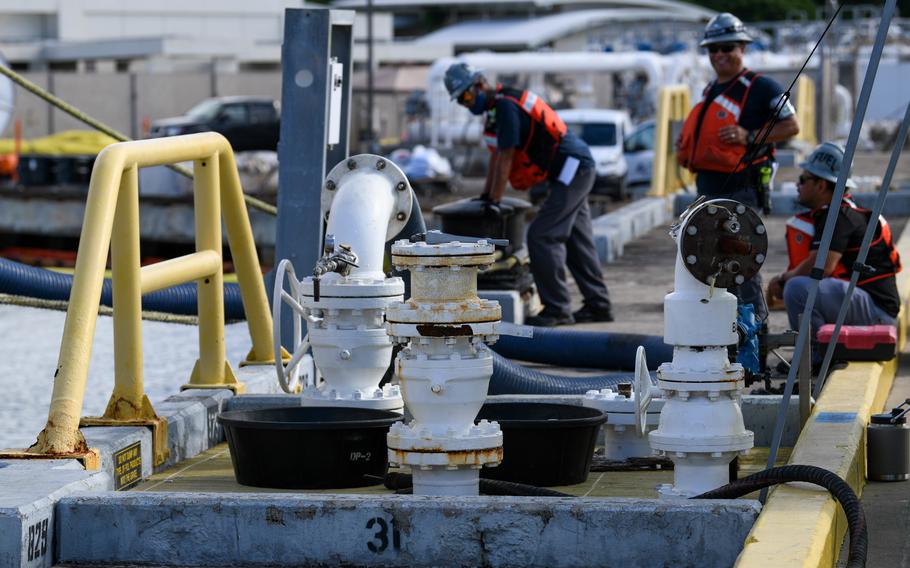
Workers at the Naval Supply Systems Command Fleet Logistics Center at Pearl Harbor in Hawaii begin on Oct. 27, 2022, to remove approximately one million gallons of fuel from three primary fuel pipelines connecting the Red Hill Bulk Fuel Storage Facility to fuel points at Joint Base Pearl Harbor-Hickam. (Luke Cohen/U.S. Marine Corps)
WASHINGTON — The Navy will take out the fuel pipelines at the Red Hill facility in Hawaii as part of its shutdown of the site, a move that the service said Thursday will prevent storing hazardous liquids there and avoid more leaks into the nearby water supply.
“This key update demonstrates [our] commitment to never use the tanks for storage of fuel or other hazardous substance storage,” the Navy said.
The service’s Red Hill Underground Fuel Storage Facility on Oahu, about 5 miles northwest of downtown Honolulu, was closed a year ago after jet fuel was found in a well that supplies water to tens of thousands of people in military communities in the area, such as Joint Base Pearl Harbor-Hickam. Some military families said they became sick after drinking contaminated water and filed legal complaints against the Navy, which are still ongoing.
Closing the facility, however, will be a lengthy process that includes removing several million gallons of fuel from the tanks.
In December, the Defense Department decided to close Red Hill “in place,” which means the tanks will simply remain empty and dormant after the fuel is removed. But some members of the Oahu community and advocates are still concerned the military might reopen the site and store fuel there in the future, especially with the U.S. commitment to a “free and open Indo-Pacific region” and potential national security threats from China.
The Navy on Thursday filed an update to the closure plan that promised to also dismantle Red Hill’s three fuel pipelines, which carried fuel to and from a pump room at Pearl Harbor a few miles away. Taking out those pipelines would make it much more difficult for the Navy to resume fuel storage at Red Hill. Previously, the Navy was planning only to clean out the pipelines.
“With the pipelines removed, the tanks cannot be refilled with fuel,” the 12-page update to the Navy plan states. “Thus, pipeline removal is a clear and tangible demonstration of [our] commitment to the public, regulatory agencies, and other stakeholders that the Red Hill facility will never be used again for storage of fuel or hazardous chemicals.”
Ernie Lau, the manager and chief engineer of the Honolulu Board of Water Supply and a major opponent of storing fuel at Red Hill, said previously that as long as the pipelines were still there, the Navy could again store fuel there one day. He called the Navy’s updated plan “promising” and “a positive step.”
Meredith Berger, assistant secretary of the Navy for energy, installations and the environment, said the updated plan “continues to prioritize the Navy’s commitment to the safety of the Oahu community and environmental health, and reinforces our assurance of transparency.”
Entirely removing the pipelines, the Navy said, provides three other major benefits — it completely removes residual fuel from the pipes, it creates more space for future “non-fuel reuse” and it cuts out long-term maintenance costs. The Navy hasn’t said much yet, however, about what could be the future non-fuel reuse of the Red Hill site.
Officials have said the defueling process at Red Hill is expected to take until at least January. The final closure of the site will take about three years and cost roughly $120 million. The Navy said dismantling the pipelines will not affect the schedule.
Last year, the Navy also considered three other options for closing the Red Hill facility, all of which were more expensive and would take longer to complete. A contractor analyzed all four options and agreed with the Navy that closing Red Hill “in place” was the best one.
While encouraged by the Navy’s updated plan, Lau said he would have no concerns if the Navy took two more steps in closing Red Hill — shutting down the pump room in Pearl Harbor and removing the steel liners in all 20 storage tanks.
“Because there could also be trapped fuel behind the quarter-inch steel plate that’s been gathering there for the last 80 years,” he said.
Lau also recommended filling the 20 empty storage tanks at Red Hill with an inert material to ensure they can’t store fuel in the future.
Pulling the steel liners and filling the tanks with a safe material, however, have already been rejected by the Navy. Both were suggested separately as two of the other closure options that the Navy considered. The contractor’s analysis in December said the option to refill the tanks with an inert material would cost $443 million and take five years to complete and the option to remove the steel liners would take $581 million and seven years.
The Hawaii Department of Health and Environmental Protection Agency still must sign off on the Pentagon’s Red Hill closure plan. The state’s health department said it is reviewing the plan, which it received Wednesday.